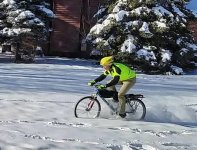This winter in My part of California has been unusually wet and colder than usual. 2.5 months of storm after storm has produced more rain than the previous 5 years.
Mud Slides and standing water on the roadways .
and when it has not been raining it has been cold, so I have felt what you talk about , the Wind Chill Factor.
In Fact because of this I have not done the testing that I have been wanting to do, since riding over 15 mph has made me very cold so I had mostly kept the speed down to 15 or less.
I did not get a 328 rpm Q100c , I bought the motor locally from someone who only had the 201 rpm version, so that is what I am running, I would rather have gotten a 260 rpm version of the Q100c but BMS Battery did not carry that , and I did not know about elife or greenbikekit companies, or if they even have a 260 rpm version of the cassette version of Q100.
Since my Last post I have started to use different batteries. Lipo now, first 2 x 6s packs (18 - 20 mph max ) , and now for the last 3 rides 2x 7s and for the last ride I had made my own Series/Parallel Harness so now using 4 x 7s Lipo's .
The 14 s is not giving me much speed faster than the 13s Li-Ion pack that I had, only about 1-2 mph faster, since I have the 201 rpm motor on 700c x 35mm tires, I am only getting about 21-22 mph or 23 top with me pedaling as hard as my legs and cardiovascular system can handle.
However I think part of the lack of expected/desired speed is the Aerodynamic Drag that I am getting/having when going 16 mph, My Road Bike is a Flat Bar Bike, upper body position is between a Road Bike and a Mountain Bike, and I usually have a beam rack on the seat post, which now carries 2 of the 4 7s packs.
To give you an Idea of Aerodynamic Factors , on my 2nd run with a 14s pack I saw a rider , on a back country road coming the opposite way, when we passed I noticed that he was riding a Specialized Shiv TT , so I turned around to see what kind of speed he was doing, he turned onto a road that goes up hill for a mile so I passed him there, and waited at the top, when he passed by I told him I was going to follow him only to the next road which is 0.8 of a Mile downhill, I was adjusting something so started off 3-4 seconds behind him, I gave the bike full throttle and peddled almost as fast as I could, but only got up to about 26-28 mph Max, Downhill . I did not even catch up to him ! less than a mile , and 231 feet of elevation drop , but because of his better Aerodynamics he, with no motor at all, was just a little faster than me .
In about a month I will experiment with a 16s pack , with the 201 rpm wind Q100c motor on 700c wheel and see what the difference is . from 13s to 14 s only produced 1-2 mph faster.
From what I have experienced on the Q100c so far , I think that a 260 rpm cassette version , with some improvements in the materials in the motor , ( tighter tolerances / better bearings / better or more grease , stronger clutch / etc. ) running on 14s - 16s is what it will take to be able to ride at the same rate as club riders,
at least for me .
chas58 said:
Last year I was doing 40-50 mile daily commutes at 25mph with the little motors and little battery (10s3p)
Early on I had burned out some controllers on the mountain bike (300rpm motor) if I ran them at full throttle for over an hour inside the frame pack. But putting the controller in fresh air solves the problem. Regular running 2 hours a day isn't a problem.
as for the 48v, well the problem you described is why Luna Cycles sells 52v batteries. As for you specifically, if you have a 48v battery, you could use the 260rpm motor and get about 24-25mph. (or more specifically for you, your speed would increase 30%)



